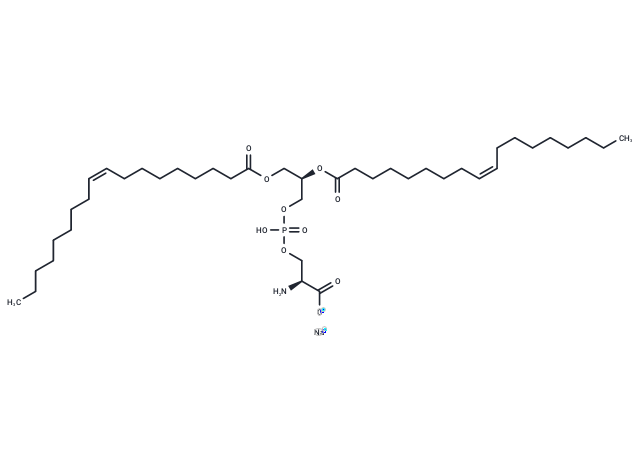Shopping Cart
- Remove All
 Your shopping cart is currently empty
Your shopping cart is currently empty

1,2-Dioleoyl-sn-glycero-3-phospho-L-serine sodium (1,2-Dioleoyl-sn-glycero-3-PS (sodium salt)) can be used in lipid mixtures with DOPC and DOPE as effective nontoxic and nonviral DNA vectors. It has been utilized in the formation of unilamellar vesicles to study membrane structure curvature and in supported lipid bilayers to examine the impact of various support materials on lipid redistribution between membrane leaflets.

| Pack Size | Price | Availability | Quantity |
|---|---|---|---|
| 5 mg | $31 | In Stock | |
| 10 mg | $48 | In Stock | |
| 25 mg | $97 | In Stock | |
| 50 mg | $166 | In Stock | |
| 100 mg | $265 | In Stock | |
| 200 mg | $439 | In Stock |
| Description | 1,2-Dioleoyl-sn-glycero-3-phospho-L-serine sodium (1,2-Dioleoyl-sn-glycero-3-PS (sodium salt)) can be used in lipid mixtures with DOPC and DOPE as effective nontoxic and nonviral DNA vectors. It has been utilized in the formation of unilamellar vesicles to study membrane structure curvature and in supported lipid bilayers to examine the impact of various support materials on lipid redistribution between membrane leaflets. |
| Alias | 1,2-Dioleoyl-sn-glycero-3-PS (sodium salt) |
| Molecular Weight | 810.04 |
| Formula | C42H77NNaO10P |
| Cas No. | 90693-88-2 |
| Smiles | [O-]C([C@@H](N)COP(OC[C@@H](COC(CCCCCCC/C=C\CCCCCCCC)=O)OC(CCCCCCC/C=C\CCCCCCCC)=O)(O)=O)=O.[Na+] |
| Relative Density. | no data available |
| Storage | Powder: -20°C for 3 years | In solvent: -80°C for 1 year | ||||||||||||||||||||||||||||||
| Solubility Information | Ethanol: 1.8 mg/mL (2.22 mM), when pH is adjusted to 3 with HCl. Sonication and heating to 60℃ are recommended. Chloroform: 10 mg/mL (12.35 mM), Sonication is recommended. DMSO: 6.25 mg/mL (7.72 mM), Sonication is recommended. | ||||||||||||||||||||||||||||||
Solution Preparation Table | |||||||||||||||||||||||||||||||
Ethanol/DMSO/Chloroform
DMSO/Chloroform
Chloroform
| |||||||||||||||||||||||||||||||

Copyright © 2015-2025 TargetMol Chemicals Inc. All Rights Reserved.